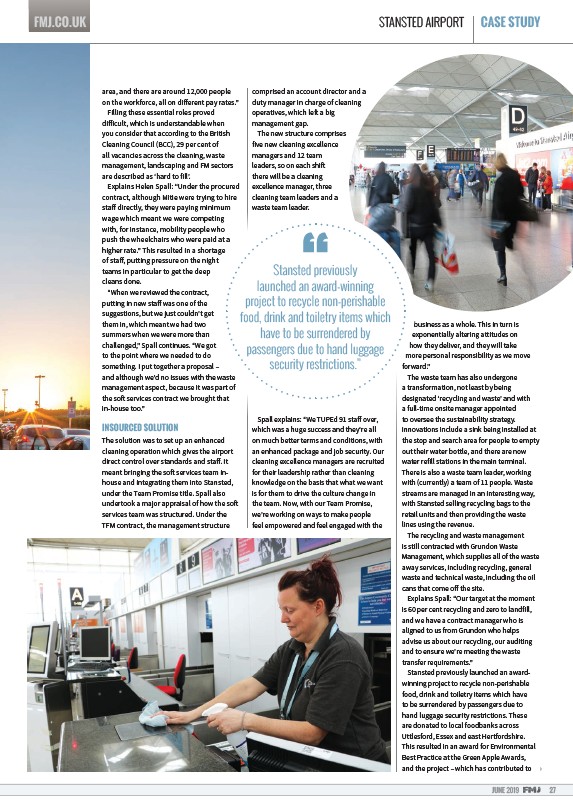
FMJ.CO.UK STANSTED AIRPORT CASE STUDY
JUNE 2019 27
area, and there are around 12,000 people
on the workforce, all on di erent pay rates.”
Filling these essential roles proved
di icult, which is understandable when
you consider that according to the British
Cleaning Council (BCC), 29 per cent of
all vacancies across the cleaning, waste
management, landscaping and FM sectors
are described as ‘hard to fill’.
Explains Helen Spall: “Under the procured
contract, although Mitie were trying to hire
sta directly, they were paying minimum
wage which meant we were competing
with, for instance, mobility people who
push the wheelchairs who were paid at a
higher rate.” This resulted in a shortage
of sta , putting pressure on the night
teams in particular to get the deep
cleans done.
“When we reviewed the contract,
putting in new sta was one of the
suggestions, but we just couldn’t get
them in, which meant we had two
summers when we were more than
challenged,” Spall continues. “We got
to the point where we needed to do
something. I put together a proposal –
and although we’d no issues with the waste
management aspect, because it was part of
the so services contract we brought that
in-house too.”
INSOURCED SOLUTION
The solution was to set up an enhanced
cleaning operation which gives the airport
direct control over standards and sta . It
meant bringing the so services team inhouse
and integrating them into Stansted,
under the Team Promise title. Spall also
undertook a major appraisal of how the so
services team was structured. Under the
TFM contract, the management structure
comprised an account director and a
duty manager in charge of cleaning
operatives, which le a big
management gap.
The new structure comprises
five new cleaning excellence
managers and 12 team
leaders, so on each shi
there will be a cleaning
excellence manager, three
cleaning team leaders and a
waste team leader.
Spall explains: “We TUPEd 91 sta over,
which was a huge success and they’re all
on much better terms and conditions, with
an enhanced package and job security. Our
cleaning excellence managers are recruited
for their leadership rather than cleaning
knowledge on the basis that what we want
is for them to drive the culture change in
the team. Now, with our Team Promise,
we’re working on ways to make people
feel empowered and feel engaged with the
business as a whole. This in turn is
exponentially altering attitudes on
how they deliver, and they will take
more personal responsibility as we move
forward.”
The waste team has also undergone
a transformation, not least by being
designated ‘recycling and waste’ and with
a full-time onsite manager appointed
to oversee the sustainability strategy.
Innovations include a sink being installed at
the stop and search area for people to empty
out their water bottle, and there are now
water refill stations in the main terminal.
There is also a waste team leader, working
with (currently) a team of 11 people. Waste
streams are managed in an interesting way,
with Stansted selling recycling bags to the
retail units and then providing the waste
lines using the revenue.
The recycling and waste management
is still contracted with Grundon Waste
Management, which supplies all of the waste
away services, including recycling, general
waste and technical waste, including the oil
cans that come o the site.
Explains Spall: “Our target at the moment
is 60 per cent recycling and zero to landfill,
and we have a contract manager who is
aligned to us from Grundon who helps
advise us about our recycling, our auditing
and to ensure we’re meeting the waste
transfer requirements.”
Stansted previously launched an awardwinning
project to recycle non-perishable
food, drink and toiletry items which have
to be surrendered by passengers due to
hand luggage security restrictions. These
are donated to local foodbanks across
Uttlesford, Essex and east Hertfordshire.
This resulted in an award for Environmental
Best Practice at the Green Apple Awards,
and the project – which has contributed to
Stansted previously
launched an award-winning
project to recycle non-perishable
food, drink and toiletry items which
have to be surrendered by
passengers due to hand luggage
security restrictions.”